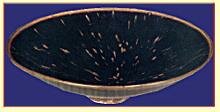|
|
|
|
|
|
||
|
Porcelain is an art of early Chinese invention and occupies an esteemed place in the World. Sung Dynasty (AD 960 - 1279) is regarded as the Classic period of the Chinese porcelain due to its beauty, elegance and equilibrium. During this period numbers of kilns began to specialize in one type of ware and sent their ware to Court as tribute. |
||
|
|
|
|
||
|
Connoisseurs in the Northern Sung Dynasty (A.D. 960 - 1279), Ming Dynasty (A.D.1368 - 1644) and Ching Dynasty (A.D. 1644 - 1911) have accorded 5 Sung Dynasty wares, the status of "FIVE GREAT WARES OF CHINA". |
||
| The following 5 Kilns produced:- "Five Great Wares" |
||||
| 1) | Ting Kilns | |||
|
Ting had the leading kilns with exceptionally fine decoration consisting of imprinted drawn and cut designs. It consists of a fine white body with an orange or reddish translucency. |
||||
|
|
||||
| 2) | Ko Kilns | |||
|
The glazed texture with many bubbles suspended in successive layers and fully netted with crackles are their major features. |
||||
|
|
||||
| 3) | Chun Kilns | |||
|
They are famous for their glazed colours such as red, blue, green and purple together with amazing transformations during firing. According to their appearance, Chun ware falls into four groups, namely green, lavender-blue, lavender-blue with purple splashes and purple-and-blue streaked. |
||||
|
|
||||
| 4) | Kuan kilns | |||
|
Kuan ware is also known as "Official" ware. The glaze and the fineness are the major features of Kuan wares. |
||||
|
|
||||
| 5) | Ju Kilns | |||
|
The Ju kilns produced porcelain with a thick unctuous glaze which resembles the most expensive type of jade in China known as "Mutton fat". Due to the limited production in that period, there are only 30 pieces in private and public ownership today. |
||||
|
|
 |
|||
|
|
|
|
Sung Dynasty (AD 960 - 1279) |
||
|
|
 |
||
 |
 |
||
|
|
Ming Dynasty (A.D.1368 - 1644) |
||
|
|
|
||
|
|
Ching Dynasty (A.D. 1644 - 1911) |
||
|
|
|
||
|
|
|
||
|
|
|
||
|
|
|
|